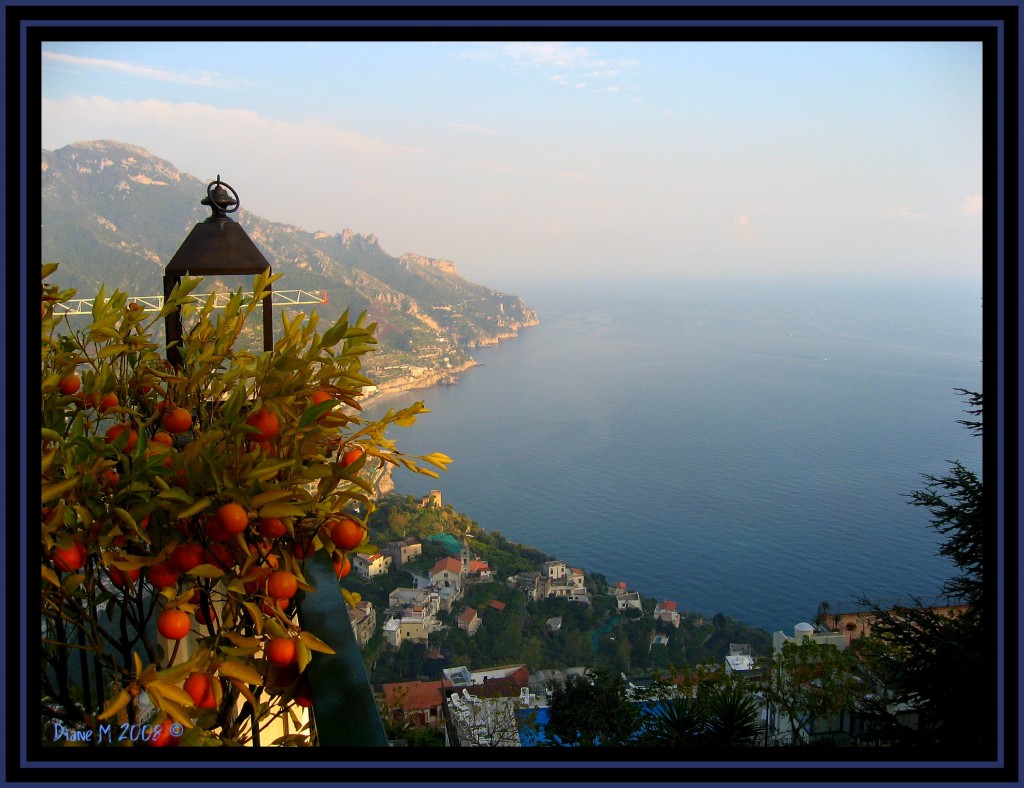
View from Palazzo Sasso by MDIANEM
Where
When most people abroad think of Italian food, they think largely about food from Campania and Sicilia (Sicily). This is because the diaspora of Italian immigrants over the past has drawn mainly from these two regions of Italy. Pizza, and dried pasta, “i maccheroni” to the locals, the two most iconic foods associated with Italy were born here. Pizza is from Naploli (Naples), the capital of Campania. Napoli is also where the dried pasta industry proliferated, coinciding with the industrial revolution when commercial methods for drying and packaging it were developed.
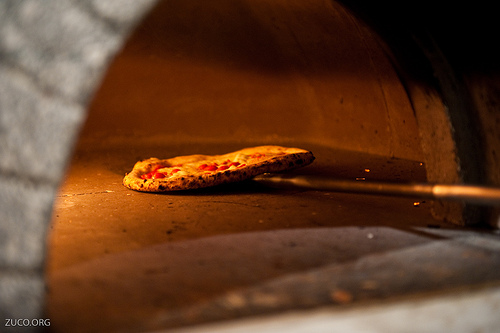
Pizza by Pietro Zuco
Neapolitans are known for being very warm and for their good humour. They are known for having a taste for very flavourful food which is simply cooked. They are, undeservedly, also famous for crime in their city and the mafia.
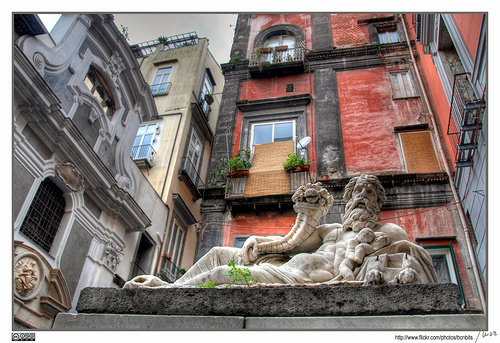
Il Nilo, Napoli by MorBCN
Campania has a long coastline along the Mediterranean with stunning towns one more spectacular than the next winding along the shore road and dotting the scenic islands as well. The region borders Lazio to the north, Molise and Puglia (Apulia) to the east, and Basilicata to the south. Campania has a rich and tumultuous history from being colonised by the Romans, Lombards, Byzantines, Arabs, Normans, and then the French/Spanish Bourbons, who ruled the Kingdom of Naples. Campania is also home to Monte Vesuvio (Mount Vesuvius), the volcano that famously erupted in AD 79, destroying the towns of Pompeii and Ercolano (Herculaneum). Both of these ancient cities are fairly well preserved and their ruins can be visited.
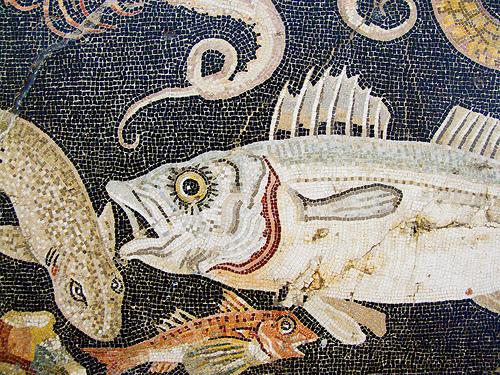
Mosaic in Pompeii from the 2nd century BC by Chris Beckett
What to See
Napoli, while chaotic, should not be missed if not for its food, for its great architecture. Spaccanapoli (which means “Naples splitter”) is the main promenade in the historic centre which divides the city and along its route are the most important sites and museums (the Museo Archeologico Nazionale (Naples National Archaeological Museum) and the Galleria Nazionale di Capodimonte (National Gallery of Capodimonte) in particular). The Reggia di Caserta (Royal Palace of Caserta)is a spectacular Baroque palace that was the former residence of the Bourbon kings of Naples and today is a UNESCO World Heritage site.
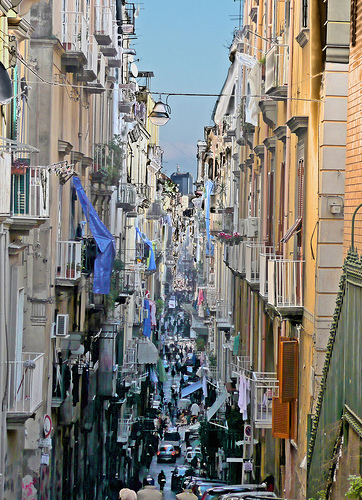
Spaccanapoli by Vin
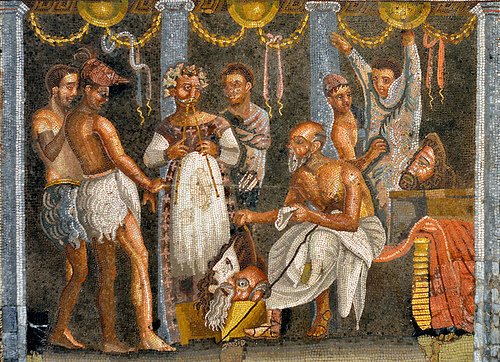
Mosaic from the Museo Archeologico Nazionale by Thom
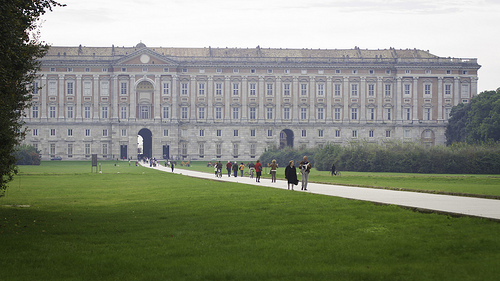
Reggia di Caserta by Nicola

Reggia di Caserta by McMamauri
The very posh island of Capri (where caprese salad comes from) has inspired many famous authors and Roman emperors. Notable excursions include a visit to the Grotta Azzurra (a marine cave), Anacapri, Monte Solaro, and a take boat trip around the island.
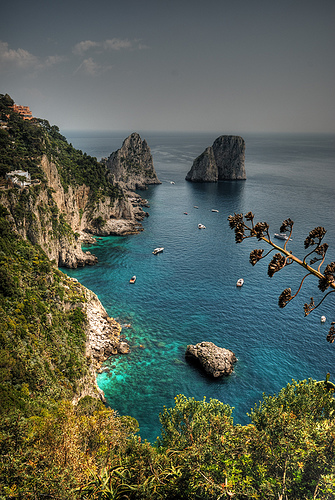
Capri by Francesco Sgroi
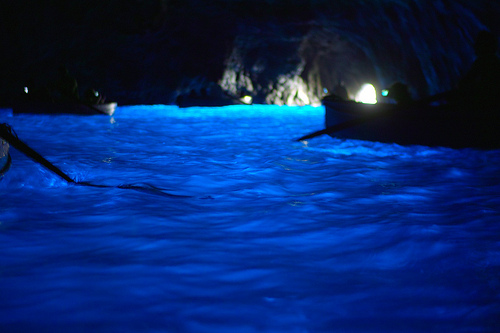
Grotto Azzurra, Capri by Jin Nakazawa
The lush island of Ischia with its beautiful landscapes, good wine, and thermal baths must be experienced. Not to be missed is the Costiera Amalfitana (Amalfi Coast), famous for charming fishing villages and loved by artists and the international jet-set. In the Amalfi, the main places to see are Positano, the Vallone di Furore, Grotta Smeralda (a marine cave), Amalfi, Ravello (See Villa Rufolo and Villa Cimbrane), and the medieval town of Salerno.

Cupola in Positano
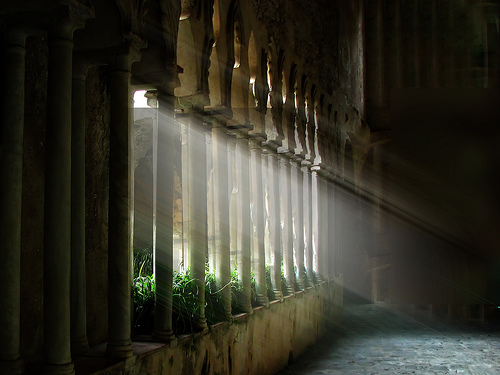
Ravello by Dick Jensen
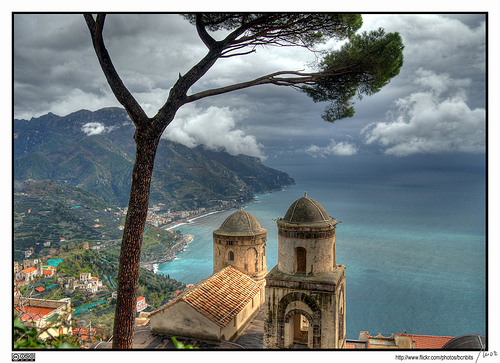
Ravello by MorBCN
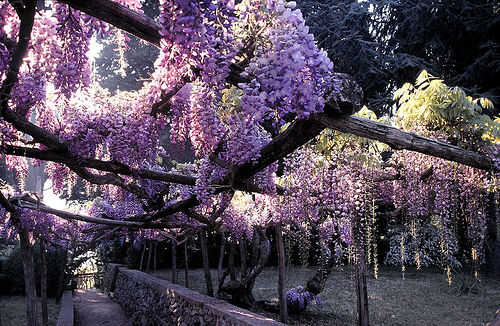
Villa Cimbrone, Ravello by Stijn Neuwendijk
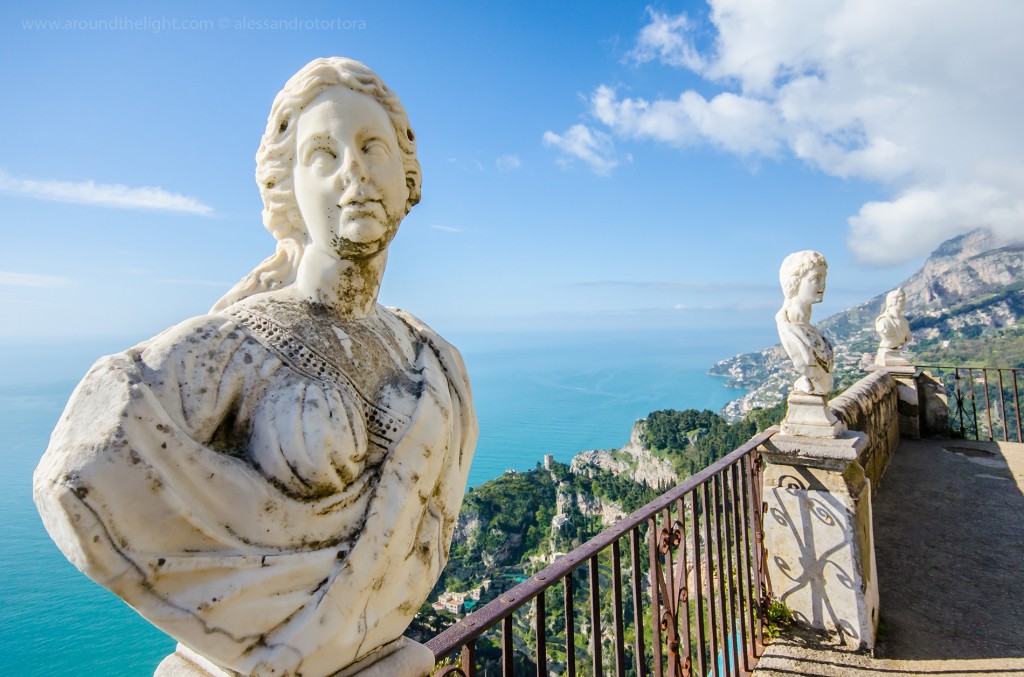
Statues at Villa Cimbrone, Ravello by Alessandro Tortora
The Golfo di Napoli (Bay of Naples) is a gorgeous area to discover, particularly from Napoli to Cuma. Along this stretch are the Campi Flegrei (Phlegraean Fields), a volcano and national park which has the Solfatara crater, the mythological home of Vulcan (the Roman god of fire). Spirits of the unsuspecting citizens of Pompeii who were buried under lava in the eruption of Vesuvius over two millennia ago still seem to inhabit the Roman ruins of that ancient city, today a UNESCO World Heritage Site. From Napoli drive south stopping in at Ercolano, ruins of another ancient city destroyed by the volcanic eruption; Monte Vesuvio, an active volcano; then Torre Anunziata to see Villa di Oplontis; and then finish in Pompeii to visit the ruins.
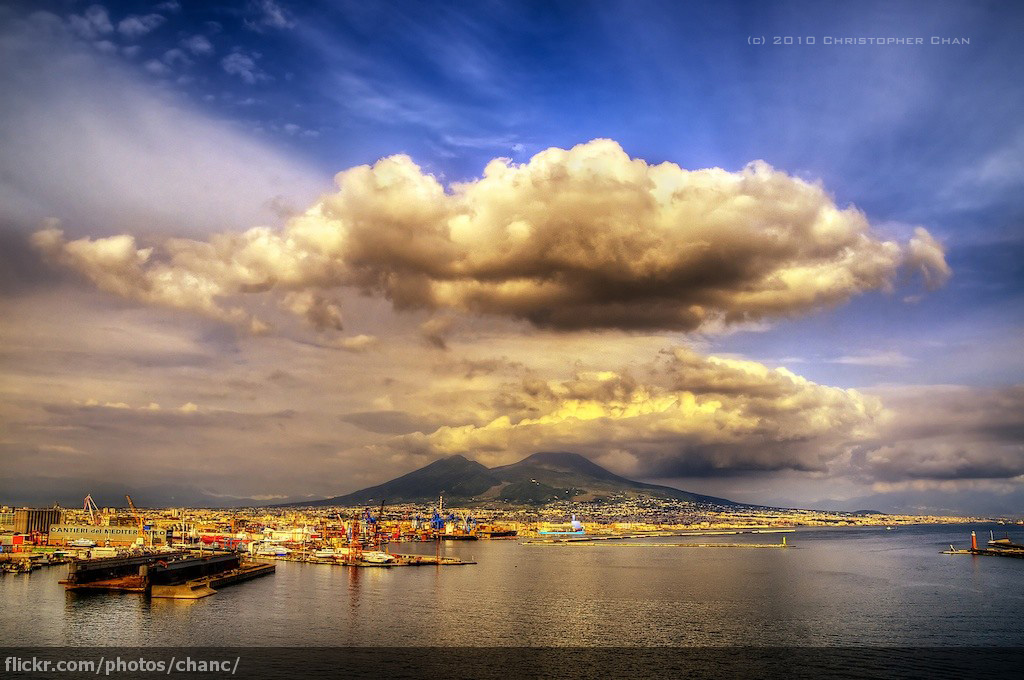
Golfo di Napoli and Monte Vesuvio by Christopher Chan

Boats by Vittorio Pandolfi
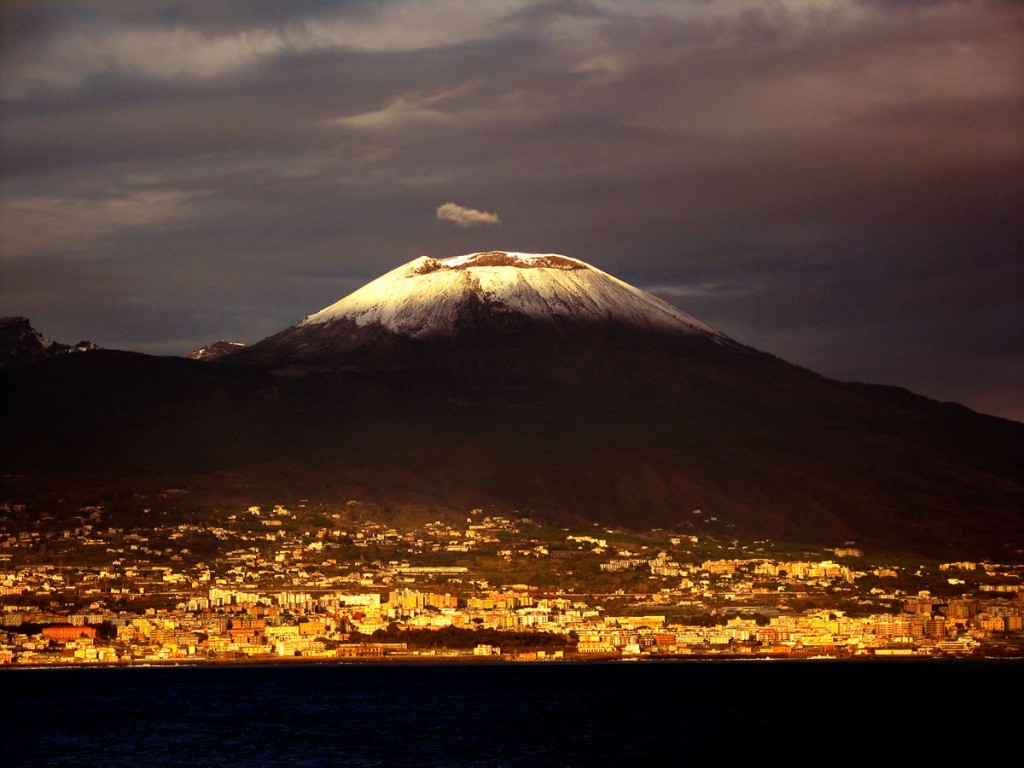
Il Vesuvio by Tom Wachtel
The Sorrentine Peninsula (Sorrento Peninsula) offers a spectacular drive atop the high cliffs that follow the curves of this fabled coastline. One of the best views of the Golfo di Napoli , Monte Vesuvio, and Isola di Capri may be from the town of Sorrento, reached easily from Napoli.

Sorrento sunrise by Matthew Bordignon
Other places to visit include Benevento (an ancient town), Avellino, Castel Volturno, the Cilento coast from Cilento to Salerno, Golfo di Policastro, Paestum (an archaeological site), Isola di Procida (Procida Island), and Baia Bacoli (Bacoli Bay).
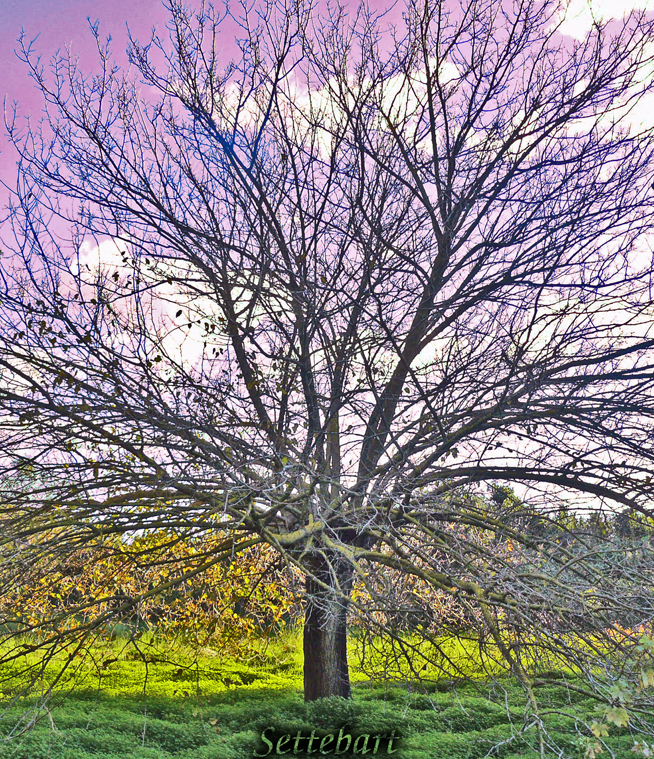
Cilento by Settebart
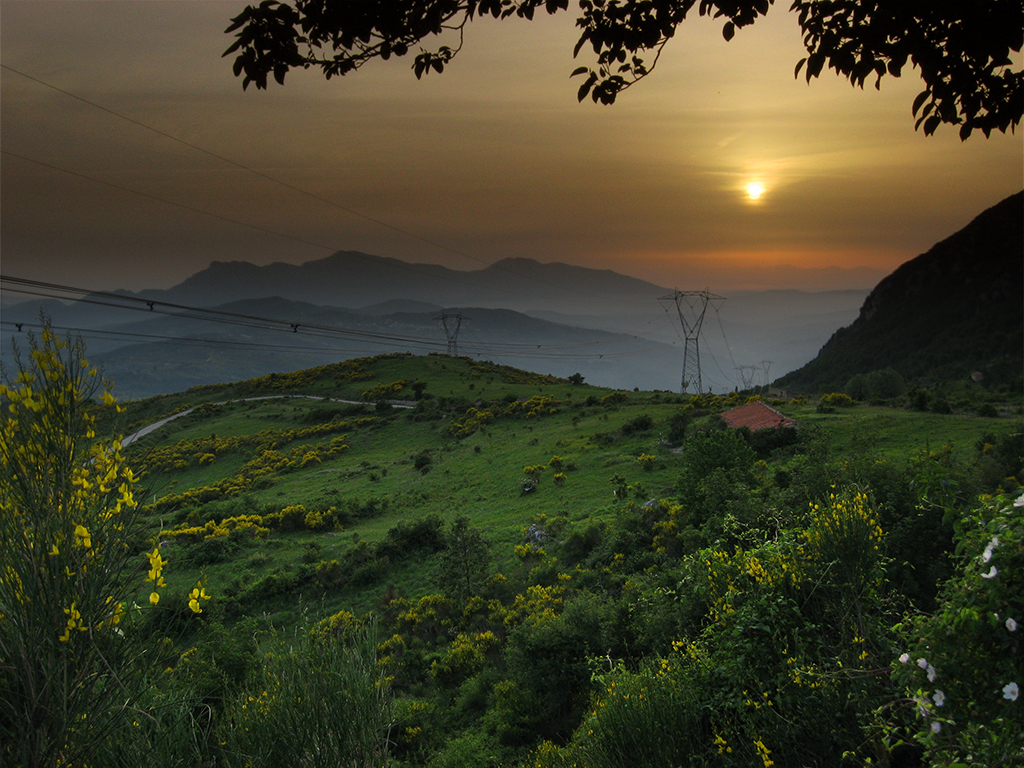
Cilento National Park by Angelo Domini
Bring home fichi secchi con miele (figs marinated in white wine, stuffed with nuts, baked and coated with honey, fennel seeds, candied citrus rinds, and anisette), ceramics from Ravello and a bottle of limoncello.

Ravello ceramics by Kate McKenna
Places to Visit:
True Neapolitan pizzerias:
Pizzeria Di Matteo
Via Tribunali, 93/94 80138 Naples Tel: +39.081455262 http://www.pizzeriadimatteo.comClosed Sundays and the 2nd and 3rd weeks of August. Excellent pizza, no points for décor.
Antica Pizzeria Da Michele
Via Cesare Sersale, 1/3/5/7 80100 Naples +39.081 553 9204 http://www.damichele.net/January to April- closed on Sundays. Excellent pizza. Must queue for a table.
Antica Pizzeria Gino Sorbillo
Via Tribunali, 32 80138 Naples +39.081 033 1009 http://www.sorbillo.eu/Closed Sundays. Excellent pizza.
Luigi Lombardi a S. Chiara
Via Benedetto Croce, 59 Zona Piazza S. Domenico Maggiore +39.081 522 0780 http://www.pizzerialombardi.it/Closed Mondays, Christmas Day and Easter. Excellent pizza.
Pizzeria Brandi
Salita di S. Anna di Palazzo, 1-2 Zona Piazza de Plebiscito +39.081 416 928 http://www.brandi.it/It is said that the Margherita pizza was invented here on 11 June 1889 in honour of the Savoyard Queen Margherita.
The Larder
Campania is world famous for its pasta, pizza, tomato sauce, meat sauce, cheeses, fish, and desserts. The colours of the vegetables and fruit here are extremely vivid and very flavourful. The Nostrano variety of lemon grown here is considered to be Italy’s best.
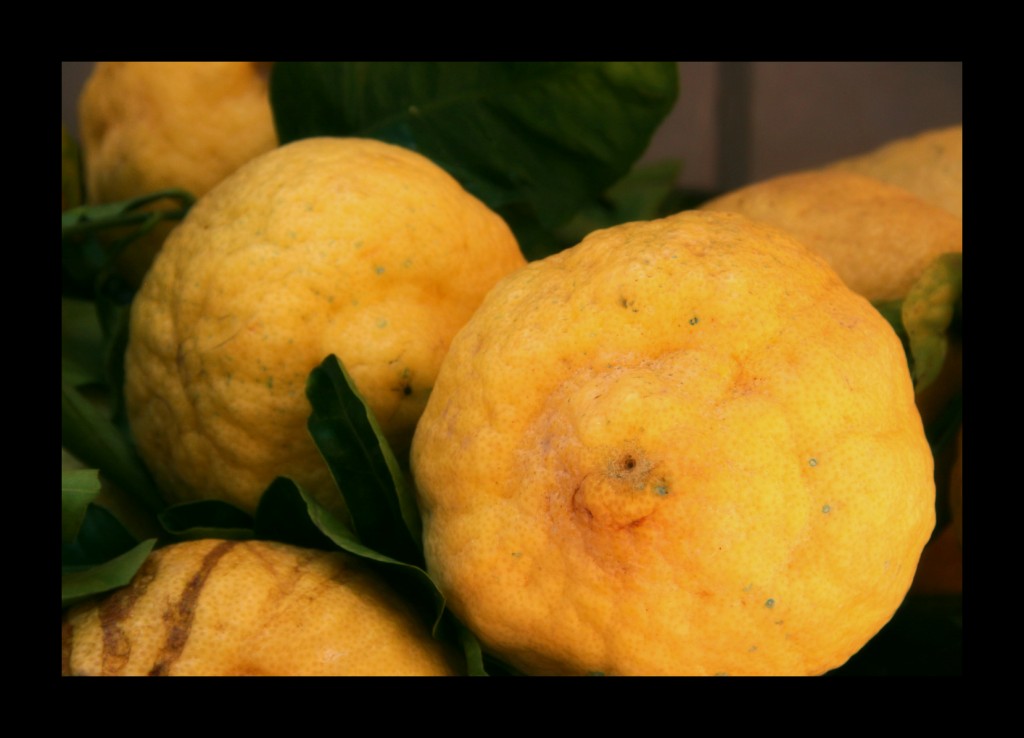
Lemons by Little Sadie
The two most iconic ingredients of Campania are tomato and mozzarella. Tomatoes, Italy’s favourite vegetable, thrive here due to the long hot summers and the volcanic soil. The most famous of the different tomato varieties is the San Marzano tomato that grows on the Vesuvian hillsides because of its intense flavour. The Neapolitans developed a process to commercially preserve tomatoes, something many Italians do at home to be able to enjoy year-round, the abundance of tomatoes their gardens produce during the summer. Now the genuine San Marzano tomato is available world-wide, its botanical authenticity and place of origin guaranteed by the D.O.P. government seal (see tomatoes in the Ingredients section for more information on the San Marzano variety and see DOP defined in the How-to section for an explanation of importance of the D.O.P. government seal).
There are many varieties of mozzarella but it is most commonly sold as a white ball of stretched curd cheese soaking in its whey. Mozzarella may also come in braids or in a pear shape (burrata). Genuine mozzarella is made from the milk of the black water buffalo and is known as mozzarella di bufala. Like the San Marzano tomato from this region, it carries an official “DOP” seal, granted to it to ensure its origin from Campania, Lazio, or Puglia–the main production areas. Mozzarella made from cow’s milk is known as fior di latte or fiordellatte. The authentic mozzarella should be eaten as fresh as possible–by local standards this means within two hours, but practically, within a day. Only recently has it been possible to vacuum-seal the mozzarella for transport abroad. Purists say that hand-made mozzarella di bufala is only worth eating on location within hours of its production, but restaurants and specialty grocers sell the vacuum-sealed cheeses to enthusiast markets abroad. Other varieties of mozzarella include provola or provolone (lightly smoked and matured), caciocavallo (a gourd shaped buffalo or cow milk cheese), and scamorza (a smoked mozzarella).
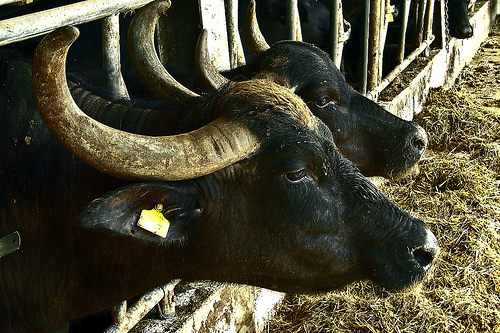
Black water buffalo whose milk is used to make mozzarella by Luana Spagna
The Golfo di Napoli is known for its tasty seafood and in the past Neapolitan seafood carts selling oysters, mussels, sea truffles, clams (vongole verace), and sea urchins were a common sight in the city. Anchovies, red fish, and sea bass are other well-known fish from the Golfo di Napoli. The fishermen arrange the fish into a curve before selling so that buyers can determine their freshness as once the fish is past its prime, rigor mortis would set in, returning the fish to its natural shape.
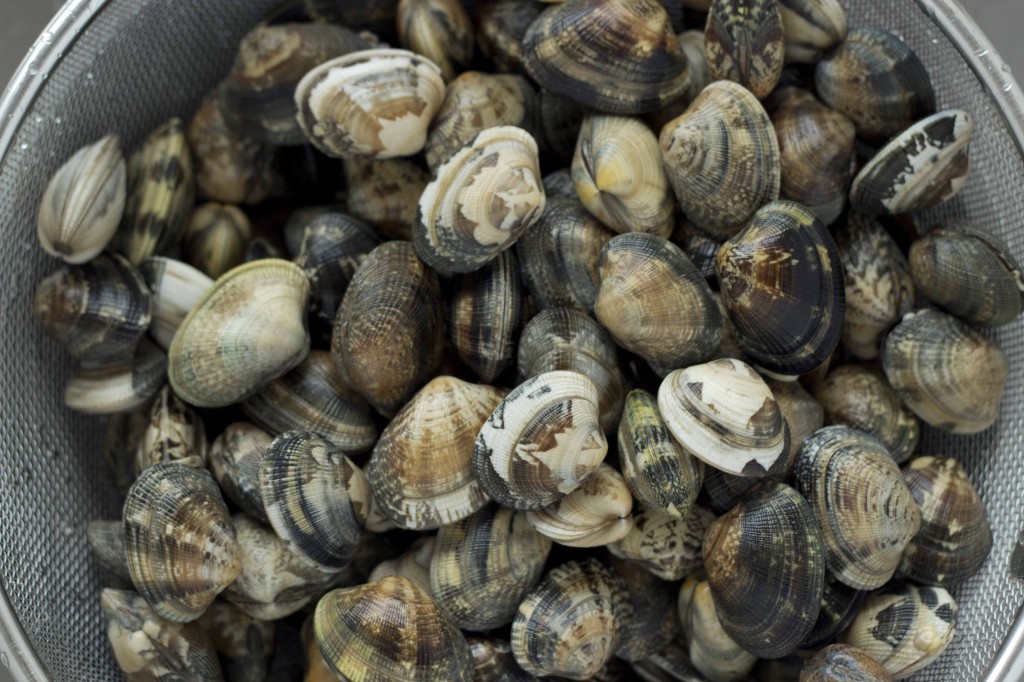
Vongole verace (Clams)
Other typical local ingredients include: olives, oranges, figs, melons, almonds, wheat, cereals, spelt, corn, cow and buffalo milk, sausages (including cervellatine, filetto e filettone di Vairano Patenora, and salsiccia di polmone), rabbit, salami, pancetta, cima di rapa buffalo meat, pork (including the semi-wild Casertana pig raised on acorns, chestnuts, and wild vegetables), goat, sheep (particularly Laticauda and Bagnolese), pork crackling (ciccoli), sardines (salted and fresh), anchovies, salt cod, mandarins, chestnuts, cherries, chicory, beans, apricot, artichokes, persimmons, lemons, apples, aubergine, hazelnuts, walnuts, potatoes, chillies, peppers, pears, peaches, cauliflower, plums, grapes, pumpkin, zucchini, and fennel. Whew. I should have just said Campania has an abundance of ingredients!
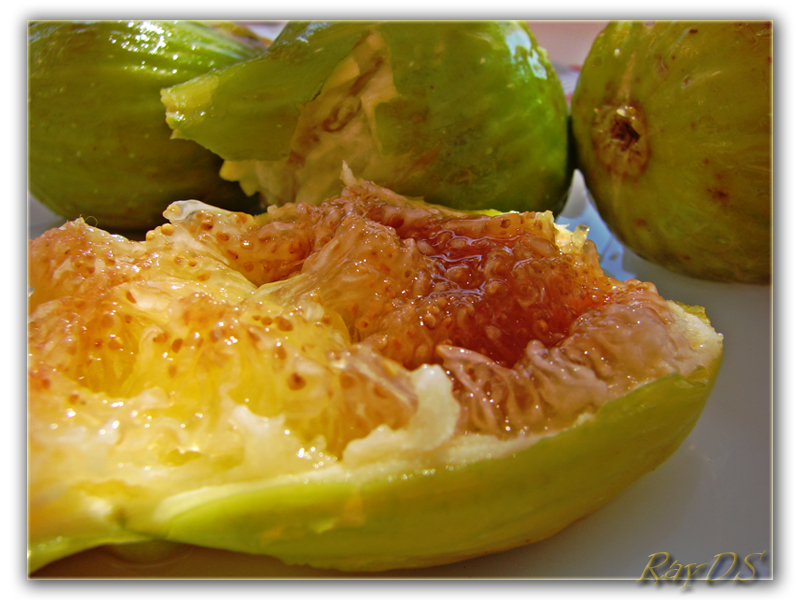
Cilento fig by RayDS
Menu
The food here is very flavourful. Festive occasions in Campania are known for the good humour of the people, the scent of pizza, and of course, for the food. Fish rather than meat, predominates in this coastal region. Their famous pasta (the best dried pasta (pasta secca) in all of Italy is made here) is topped with ragù napoletano (their signature meat sauce made from the gravy of roasted pork or beef with onion, red wine, or tomato purée). Napoli loves confections, especially elaborate pastries. Doughnuts, (frittele), and numerous other rustic sweets are deep-fried in olive oil. Sound unhealthy to you? Campania’s diet has been much analysed since the scientist Ancel Keys found the lowest rate of heart disease in the West here in the 1950’s so think again. Key’s study concluded that the predominance of pasta secca (dried pasta made with durum wheat semolina, not refined white wheat flour) and the preponderance of vegetables, including the ubiquitous tomato, is what he accounted for the low rate of heart disease. See recipes from Campania here.
The residents of Napoli are known as “mangiamaccheroni” (meaning “maccheroni eaters” – maccheroni being a general word for dried pasta) because dried pasta production started here about a hundred years ago. Pasta used to be sold by the plate by a maccheroni vender; one could pay extra for some sauce on top. It was a cheap source of food for the population, and still as popular today. Just a note, “maccheroni” in Campania means any dried, factory-produced pasta including long strand cuts such as spaghetti and stubby short ones such as penne, while north of here it means thick hollow pasta shapes, long or short. Outside Italy macaroni has come to include only short, hollow, half circle pasta shapes such as elbow macaroni, rigatoni, penne, etc.
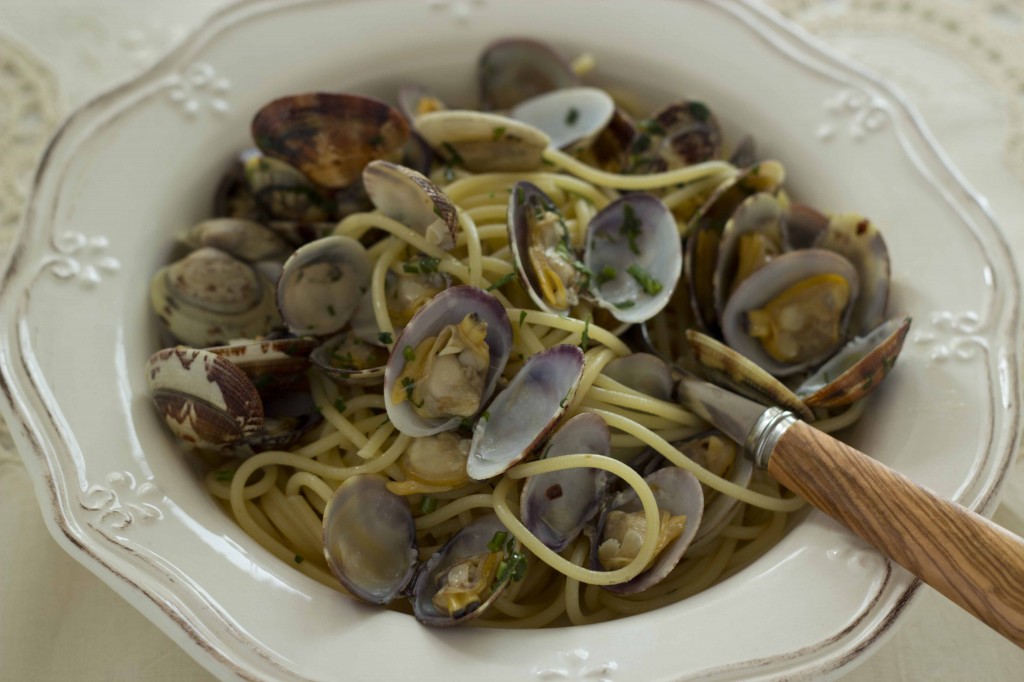
Spaghetti alle vongole (Spaghetti with clams)
The most famous dish from Campania, pizza, dates back to Roman times when it was called “picea” (and was served without tomatoes as they had not yet been introduced). Pizza is now popular all over Italy and, in fact, all over the world. Outside of Napoli, pizza began its worldwide, meteoric rise in popularity in New York when the first Neapolitan pizzeria was opened in 1905. After pizza became popular in the U.S., it eventually travelled to northern Italy, in the 1970s and 1980s. In general, although often quite delicious, pizza has rarely been successfully replicated outside of Napoli. One must go and try the real thing at least once.
So irresistible was the Neapolitan pizza that King Ferdinand I is said to have disguised himself as a commoner to be able to sneak into pizzerias. It was not considered suitable food for monarchs in those days but not be deterred, Ferdinand II had pizza ovens built near the palace so he could indulge his appetite for the pie whenever he fancied. Subsequently, the House of Savoy ascended the throne in 1861 and in 1889 Umberto I and his wife Margherita were honoured with a pizza named in Queen Margherita’s honour.
Because Campania, aside from the royal courts in Naples, was a poor province, meat and fish were scarce. Thus many of the popular dishes were focused on vegetables, cheese, breads, pizza, and pasta. Parmigiana di melanzane (aubergine layered with mozzarella and tomato) is a one of the region’s signature vegetable-based dishes (“parmigiana” refers to the scattering of parmigiano-reggiano cheese between the layers of fried aubergine, tomato sauce, and mozzarella, not to any link with Italy’s northern Parma province from whence the famous cheese comes). The royal courts in the Kingdom of Naples enjoyed an array of dishes and were famous for their master chefs, called “monzù”, who learned the art of French cooking under the Bourbons and then modified it to local preferences. The monzù devised original recipes based on lavish use of flavourful local ingredients and were known for elaborate meals which took hours to prepare. Today master chefs are still called monzù.
Campania has a serious sweet tooth and there are many desserts that are native to the region. The most famous are sfogliatella, pastiera, babà and sorbets.
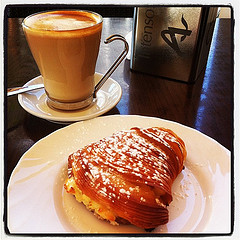
Sfogliatella by Maria Victoria Rodriguez
There are some very promising red wines made from Aglianico grapes from Taurasi and white wines from Fiano grapes from Fiano di Avellino and Greco grapes from Greco di Tufo. Reliable producers of Aglianico grape based red wines include Contrade di Taurasi, Mastroberardino, and Terradora. The best producers of Fiano di Avellino white wines include Feudi di San Gregorio, Mastroberardino, Terradora, and Villa Diamante. Producers of Greco di Tufo white wines to look for include Ciropicariello, Quintodecimo, and Terradora.
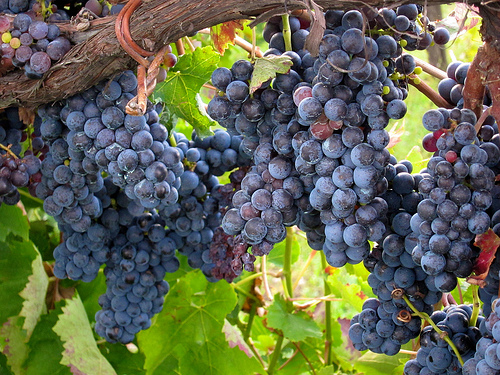
Grapes by Robbin Gheesling
One of my favourite after dinner drinks on a hot summer night is limoncello, a lemon liqueur from here.
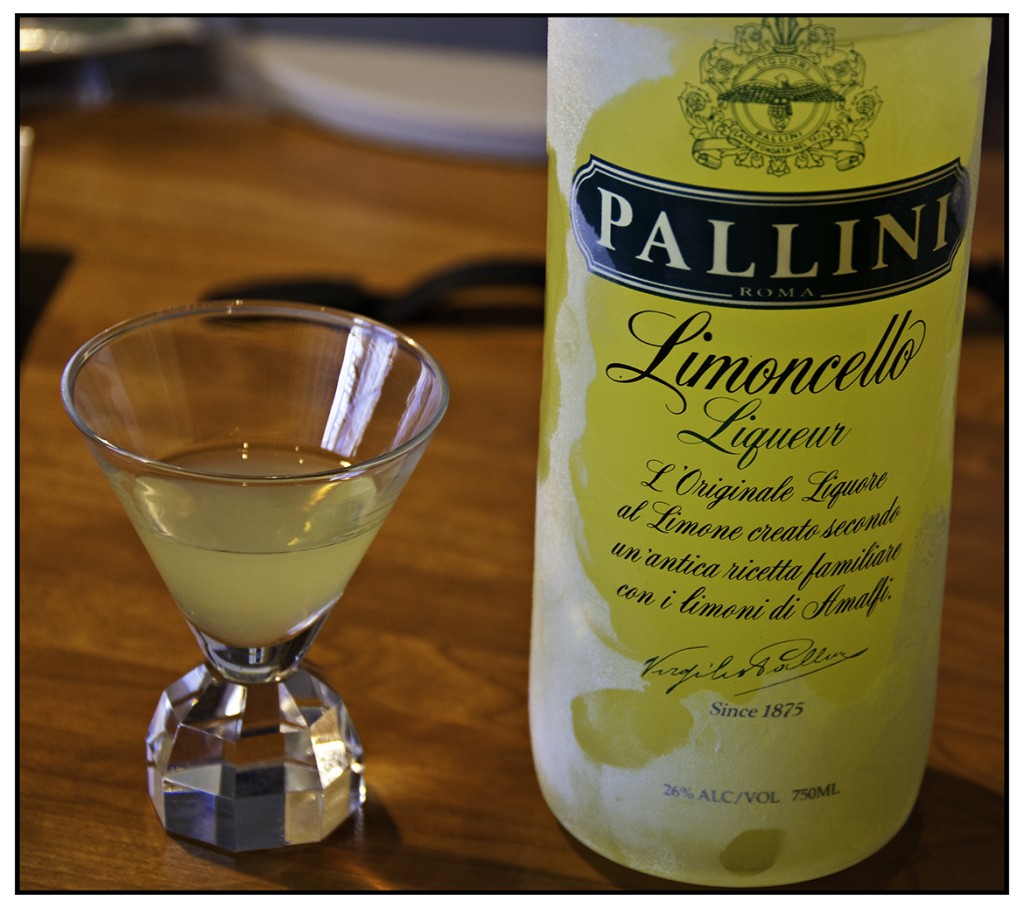
Limoncello by Seth Anderson
What to Eat
A list of typical dishes in Campania (the most classic dishes are written in bold):
Pane (Bread)
Biscotti di grano integrale e di Granone (whole wheat and corn crisp bread)
Casatiello sugna e pepe (salami or ham and pepper cheese bread)
Pane di Montecalvo (hard-grain, white wheat bread with a thick crust and hollow centre)
Pane di Padula (wood-fired mixed hard and soft grain wheat bread)
Pane di San Sebastiano (a long, white wheat bread with a thin crust which can weigh 500 grams to 2 kilos and baked in a wood oven)
Pane di Saragolla / Pane di Saraolla (a rye bread with a crunchy crust baked into round loaves in a wood oven)
Pane di Villaricca (a round, white wheat bread with a thick crunchy crust baked in a wood oven)
Scaldatelle / Scacuratiell’ (ring-shaped breads made with fennel seeds and sometimes made using eggs, which are first boiled then baked)
Taraddi con finocchio / Li taraddi cu lu funucchiu (hard bread biscuits baked into rings and flavoured with wild fennel seeds)
Taralli (hard bread biscuits baked into rings and flavoured with wine (al vino), fennel (di Agerola/al finocchietto), almonds (alle mandorle), spices and herbs (intecciati) or lard and almonds (sugne e pepe/nzogna e pepe))
Salumi (Cold Cuts)
Many of the salumi are named after their place of origin and have been made since ancient times.
Capicollo di Ricigliano (pork neck with spices, chillies, and red wine)
Fiocco di prosciutto (pear-shaped wood-smoked salami made from fresh ham from Avellino)
Fleppa (salami of pork spleen, lung, intestines, fat, and spices flavoured with orange and mandarin peels)
Mozzariello (spicy pork sausage)
Nnoglia di maiale (pork salami flavoured with orange and mandarin peels, chili powder, and wild fennel)
Prosciutto di Casaletto (ham from the Landrace pig spiced with chillies)
Prosciutto di monte (ham from the Landrace pig and Casertano pig which is slightly smoky in flavour)
Salsiccia sotto sugna di Vairano Patenora (sausage made from Casertano pig flavoured with wild fennel seeds and spices)
Samurchio (blood sausage flavoured with herbs, black pepper, and chillies)
Soppressata (smoked, cured, pork salami with lardo and seasonings)
Antipasti (Starters)
Alici marinate (marinated anchovies in vinegar, salt, and lemon, dressed with olive oil and chillies)
Caponata (a compote of sweet and sour vegetables and fish)
Cozze al pomodoro (Neapolitan mussel soup with tomatoes, garlic, parsley, and pepper)
Crocchette di uova sode (breaded and deep-fried hard-cooked eggs)
Insalata caprese (sliced tomatoes with mozzarella di bufala cheese and basil)
Pizzelle alla napoletana (filled fried pizzas)
Rissole alla napoletana (fried stuffed pastry with cheese and salami filling)
Sciusciello (hollowed-out whole wheat puffed bread filled with lard and black pepper or with a variety of fillings such as fresh cheese, meat, salami, vegetables, and potatoes)
Primi (First Courses)
Calzone napoletano (pizza stuffed with ricotta, parmigiano-reggiano and mozzarella cheeses, salami, and ham; sometimes includes egg)
Fettucine alla marinara (fettucine pasta with a fresh tomato sauce)
Gattò di patate / Panzerotto napoletani (baked purèed potatoes, eggs, mozzarella and provola cheeses, and salami)
Gnocchi alla sorrentina (baked potato dumplings with mozzarella and tomato sauce)
Lasagna napoletana / Lasagne di carnevale (lasagne pasta layered with ricotta cheese, pork or beef meat sauce, meatballs, mozzarella, and cervalline sausage, sometimes with hard-boiled eggs and baked)
Linguine all’aragosta (linguine pasta with lobster)
Maccheroni alla ragù napoletano (macaroni pasta with the gravy from a beef or pork roasted in onion, red wine, or tomato purée)
Minestra maritata / Pignatograsso / Maretato (a rich winter soup of pork ribs, tail, cheek, rind, sausage, and trotters, capon or chicken, herbs, escarole, chard, broccoli, Savoy cabbage, borage, and veal broth, caciocavallo cheese is added at the end of the cooking,originally a Spanish dish the name refers to the marriage of the vegetables and the meat and is eaten the day after Christmas)
Paccheri / Ziti / Perciatelli con sugo alla genovese (paccheri, ziti, or perciatelli pasta in meat sauce made from the gravy of boiled beef and pork with onions, lardo, tomato paste, aromatics, bay leaf, and basil; the meat is often served as a main course)
Pagnottine di Santa Chiara (baked or fried folded flour and potato flatbreads stuffed with tomatoes, anchovies, olive oil, and vinegar filling)
Panuozzo (filled elongated folded pizza with a variety of vegetables, cured meat, mushrooms, and mozzarella or provola cheeses)
Panzarotti (little fried pizzas filled with cheese, ricotta, and eggs)
Pasta al pomodoro crudo (spaghetti pasta with raw tomatoes)
Pasta e fagioli alla napoletana (soup of mixed pasta with cannellini beans, garlic, chilli, tomato, and oregano, sometimes with pancetta, lardo, or muzzarielli (spicy sausages)
Pizza migliazza cu li frittole (baked cornbread cake with pecorino cheese and lardo eaten in the winter)
Pizza con ricotta (pizza stuffed with ricotta, eggs, sausages, and prosciutto)
Pizza con salsicce e friarielli (pizza topped with sausage, and broccoli rabe sautéed in olive oil, flavoured with garlic and chillies)
Pizza di scarola / Pizza con la jeta (flatbread topped with escarole sautéed with garlic, chillies, anchovies, olives, raisins, pine nuts, and capers)
Pizza napoletana verace artigionale margherita (cheese pizza)
Pizza napoletana verace artigianale marinara (pizza with tomato, olive oil, and oregano– no cheese)
Ravioli alla napoletana (pasta crescents with mozzarella, parmigiano-reggiano, ricotta, prosciutto, and parsley filling, served with tomato or meat sauce)
Ravioli di ricotta di pecora (pasta pillows filled with sheep’s milk ricotta, pecorino, and herbs and topped with tomato or lamb meat sauce)
Ravioli capresi (cheese ravioli with tomato sauce)
Sartù di riso (an elaborate tomato-flavored rice cake filled with fried aubergine, small meatballs, mushrooms, cheese, sausage, chicken livers, and peas)
Scialatiello (fresh pasta dressed with a sauce of seafood, cherry tomatoes, basil, black pepper, and pecorino cheese)
Spaghetti aglio e olio (spaghetti with garlic, olive oil, and parsley, sometimes with chilli)
Spaghetti alle vongole (spaghetti with clams and garlic)
Tasca / Pizzichini / Pizza chiena / Pizzaghiena (flatbread filled with with parmigiano-reggiano and provolone cheeses, salami, and eggs)
Timballo di maccheroni / Timpa’no di maccheroni / Sformato ferdinandeo (short crust pastry encasing a perciatelli pasta dome filled with fried pork meatballs, chicken giblets, onion, meat sauce, mushrooms, peas, hard-boiled eggs, black truffle, and mozzarella cheese)
Tortino di patate al basilico (potato cake with basil)
Vermicelli alla carretttiera (thin spaghetti tossed with breadcrumbs sautéed with garlic, parsley, and oreganos)
Zuppa di fagioli e castagne (pasta and bean soup with chestnut)
Zuppa della nonna (soup made of tomatoes, bread, sausage, and eggs)
Zuppa di soffritto / Zuppa forte / Suffritte / Tosciano / Saporiglio (soup of pork lung, kidneys, heart, spleen, trachea, and pork rind cooked with lard, tomatoes, rosemary, red wine, bay leaf, and chilies, served with stale bread for soaking up the savory broth)
Secondi (Main Courses)
Acqua pazza (fish stewed with tomatoes, water, garlic, and olive oil, sometimes with parsley)
Alici al gratin / Alici ammollicate (baked anchovies with garlic, breadcrumbs, oil, parsley, and white wine or lemon juice, sometimes with tomato)
Ammugliatielli / Mugliatielli / Mugliatieddu / Glummarieddi / Migliatielli / Migliatieddi (roasted or stewed lamb lungs, liver, and sweetbreads wrapped in intestines around a stick and flavoured with garlic, parsley, cheese, chillies, and pecorino cheese)
Baccalà alla napoletano (pan-fried salt cod stewed with tomato, onion, and roasted peppers)
Bistecca alla pizzaiola (seared steak with stewed tomato, oregano, and garlic, sometimes finished with mozzarella on top)
Bistecchine alla napoletana (steak baked with chopped prosciutto, mushrooms, oil, and parsley; served with lemon juice)
Braciole alla napoletana (rolls of boneless pork chops filled with raisins, pine nuts, capers, and ham, first sautéed, then braised in tomato sauce)
Braciola di carne di capra (cutlet of kid goat filled with parsley, garlic, onion, then rolled up and simmered in tomato sauce)
Coniglio all’ischitana (rabbit stewed with tomatoes, white wine, garlic, thyme, chilli, rosemary, and basil)
Fegato con la zeppa / Fegato con la rezza / Fegtu ‘r puorcu cu la rezza (barbecued pork liver with bay leaves)
Frittata di maccheroni (pasta omelette)
Orata alla procidana (pan-fried sea bream with garlic, tomatoes, olives, and parsley)
Pancotto dei Foresi (soup of stale bread, turnips, asparagus, chicory, potatoes, garlic, and chillies)
Pane cotto fermo con i broccoli / Pancotto con i friarielli (broccoli rabe with stale bread, oil, garlic, and chilli)
Pane cotto con i fagioli (sautéed bread with beans and olive oil)
Polpettone alla napoletano (meatloaf)
Polpi alla Luciana (octopus with tomatoes, oil, garlic, olives, and black pepper)
Sfrionza (pork stewed with potatoes and red peppers)
Tegamino di cozze (gratinéed mussels marinated in lemon juice, vinegar, and olive oil)
Trippa alla napoletana (tripe with tomatoes, garlic, onion, and prosciutto)
Zeppoline di baccalà (salt cod fritters)
Zuppa alla marinara / Zuppa alla napoletana (fish soup with tomato, parsley, and garlic, served over toasted bread)
Contorni (Side Dishes)
Carciofi arrostiti (grilled artichokes with parsley and garlic)
Cicoria all’aglio (sautéed chicory with garlic)
Friarielli aglio e olio (broccoli rabe with garlic, chilli, and olive oil, often served with sausage)
‘Mbanata (chicory, fennel, escarole, turnips, Savoy cabbage, and San Lupo beans accompanied by a cornbread pizza)
Mugnuli soffritti (greens sautéed with salted pork belly, stale bread, and chilli)
Peperoncino verde friariello / Peperoncino verde di fiume (fried sweet peppers)
Peperoni imbottiti (red and yellow sweet peppers stuffed with fried aubergine, olives, capers, anchovy, and breadcrumbs)
Rapa e patate (turnips and potatoes with anchovies or black truffle)
Zucchine alla bella Napoli (fried zucchini layered with mozzarella and tomato sauce, baked)
Zucchine alla scapece (fried zucchini dressed with vinegar, garlic, and Roman mint)
Salse (Sauces)
Ragù napoletano (meat sauce made from the gravy from roasted beef or pork with garlic, parsley, pecorino cheese, onion, red wine, and tomato purée)
Dolci (Desserts)
Babà (an eggy lemon and vanilla-scented cake soaked in rum syrup)
Biscotti di Castellammare (sugar cookies from Castellammare)
Cartellata con mosto (fried sweet pastry soaked in grape must)
Casatiello dolce (an iced cake flavoured with candied fruit, cinnamon, vanilla, and orange blossom water)
Chiacchiere / Cenci (fried sweet dough flavoured with liqueur, sprinkled with confectioner’s sugar)
Croccante (vanilla-scented almond brittle)
Delizia al limone (lemon sponge cake balls filled with mixed whipped and lemon creams)
Follovielli (sultanas simmered in wine and wrapped with candied oranges in citrus leaves)
Migliaccio (a semolina cake flavoured with candied orange, cinnamon, and vanilla)
Mustacciuli / Mostaccioli (chocolate-coated biscuits)
Pastiera (short crust pastry tart filled with barley, corn, or rice with milk, eggs, candied citron, candied orange peel, candied pumpkin, lemon zest, orange blossom water, cinnamon, and ricotta cheese or pastry cream)
Pizza dolce / Pizza di ricotta (short crust pastry tart filled with confectioner’s
custard, ricotta cheese, candied fruit, almonds, and lemon)
Raffioli / Caffiuoli (small cakes brushed with apricot jam and glazed with sugar)
Roccocò (ring-shaped cookies flavoured with almonds, orange zest, vanilla, spices, and candied fruit)
Sanguinaccio (cream of chocolate, milk, and pig’s blood served with biscuits; nowadays most places leave out the pig’s blood)
Sfogliatella (a flaky, snail shaped pastry filled with spices, candied fruit, and ricotta cheese)
Sorbetti (frozen, flavoured ices usually of coffee, lemon, strawberry, or apricot)
Struffoli (deep-fried sweet pastry balls covered with honey and orange zest, formed into a pyramid, and decorated with confetti or icing sugar)
Susamielli (hard, round, or “S” shaped cookies with honey and nuts, served for Christmas)
Tarallo cu ll’ove (a ring-shaped cake made with eggs, sugar, and lard and flavoured with citrus fruit and vanilla.; eaten on its own or soaked in white wine)
Tarallucci al naspro (ring cookies covered with icing sugar)
Zandraglia (fried dough dipped in honey and covered with confetti)
Zeppola fritta (cinnamon sugar doughnuts)
Formaggi (Cheeses)
Bebe di Sorrento (a sweet cow’s milk cheese aged a few days)
Bocconcini di bufala (small balls of buffalo mozzarella covered in cream and sold in glazed terracotta)
Burrino di bufala / Burrata di bufala (an extremely creamy buffalo mozzarella encasing butter, must be eaten within a week of production)
Cacioricotta (a fresh cow’s milk cheese)
Caciotta di capra (fresh or matured goat’s milk cheese, when mature it is conserved in terracotta, glass, or olive oil and served grated; a prized variety is from Cilento)
Caciottina canestrata di Sorrento (fresh cow’s milk cheese formed into tiny wheels in wicker moulds and sold wrapped in parchment paper, from the Sorrentine Peninsula)
Fior di latte (a medium-soft, fresh, stretched curd cheese from cow’s milk which has been made since ancient times, produced in Campania, Lazio, Molise, Puglia, Basilicata, and Calabria)
Mozzarella di Bufala Campana DOP (a medium-soft, fresh, stretched-curd, cheese from buffalo’s milk, produced in Campania since the 13th century)
Pecorino salaprese (a soft, fresh ewe’s milk cheese; the name “salaprese” means “just salted,” produced in Avellino, Benevento, Caserta, and Salerno)
Provola affumicata (smoked mozzarella, produced all over Campania)
Provolone del Monaco DOP (a semi-hard, cow’s milk cheese from the Agerola cow; the name means “monk’s provolone,” referring to the ancient dairy heritage of Caserta)
Riavulillo (an ancient cow’s milk cheese with a black olive and chilli pepper centre, from Napoli; every August the village of Arola has a fair dedicated to this cheese)
Ricotta di Fuscella (a fresh cow’s milk cheese)
Ricotta fresca ed essiccata di bufala (fresh or dried buffalo’s milk cheese)
Scamorza di bufala (a fresh buffalo milk cheese, can be smoked or not)
Treccia (braided mozzarella)
Bevande (Drinks)
Amarene al liquore (cherry liqueur)
Limoncello (a lemon -lavoured liqueur)
Strega (a herbal liqueur from Benevento)
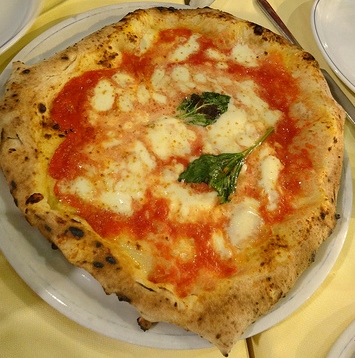
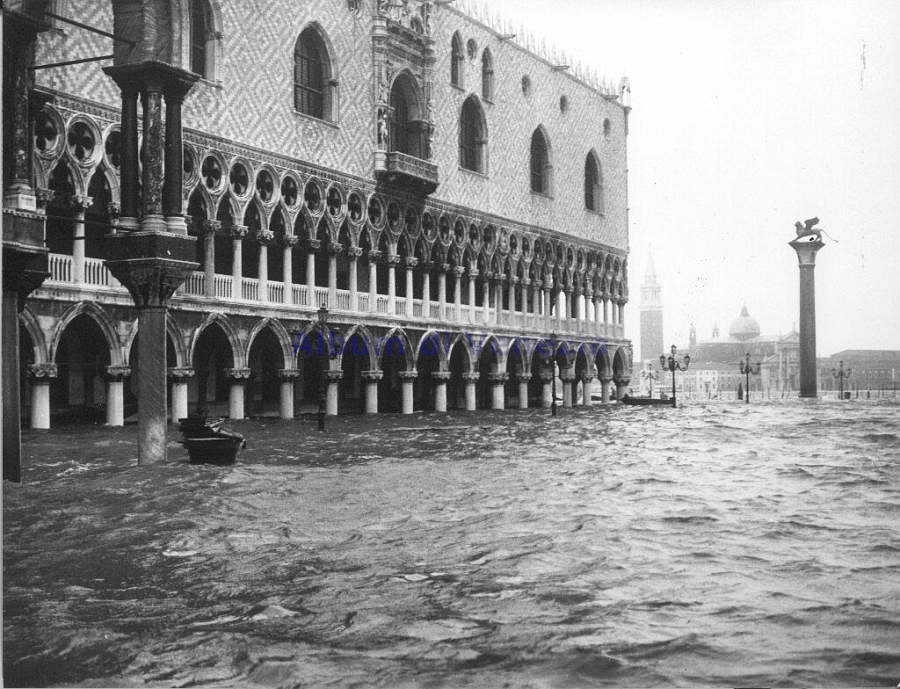
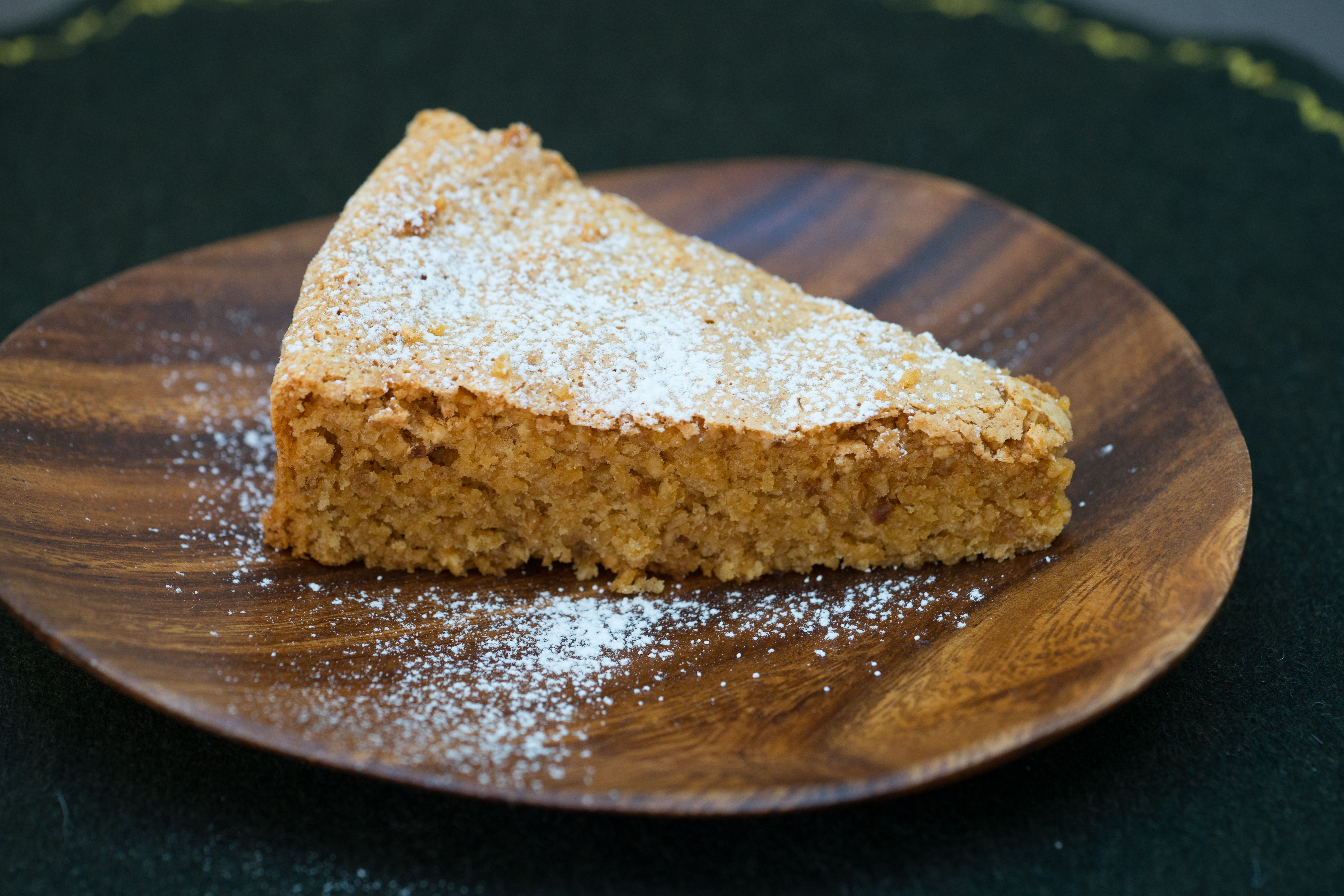
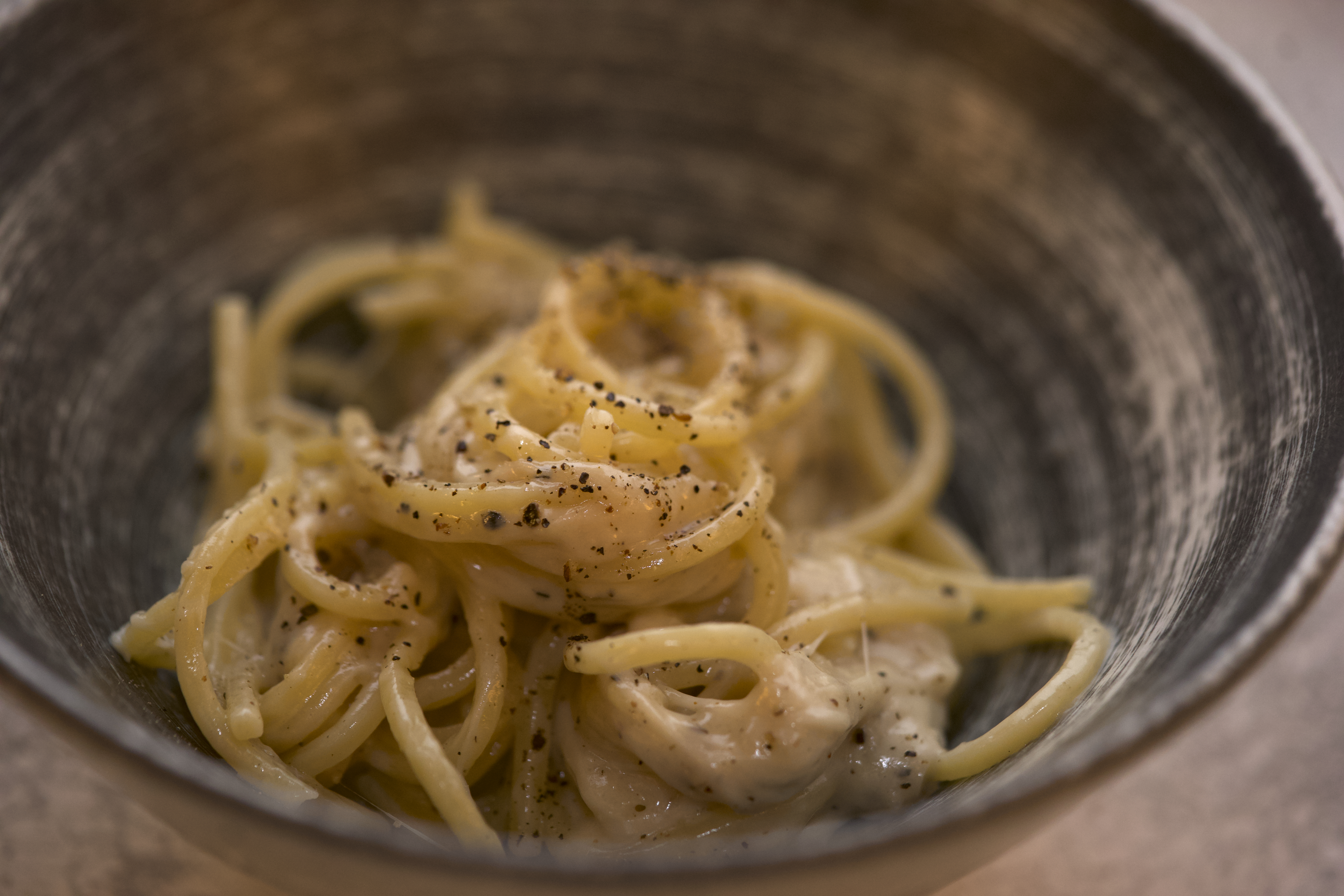
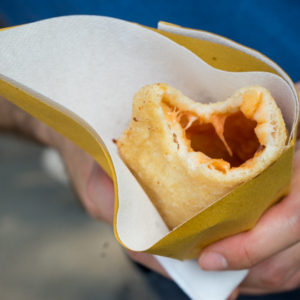
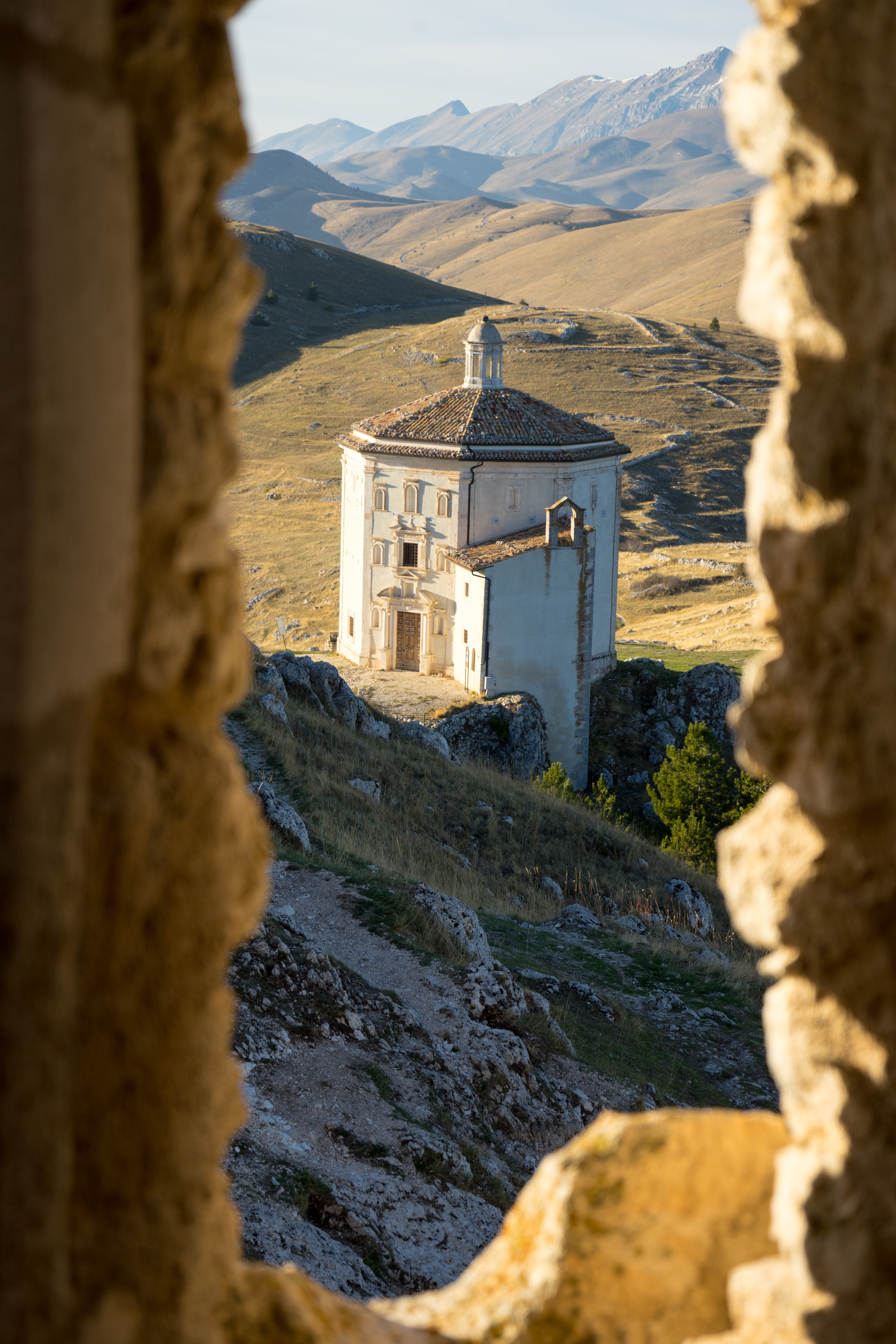
Leave a Reply